- Author: Kathy Keatley Garvey
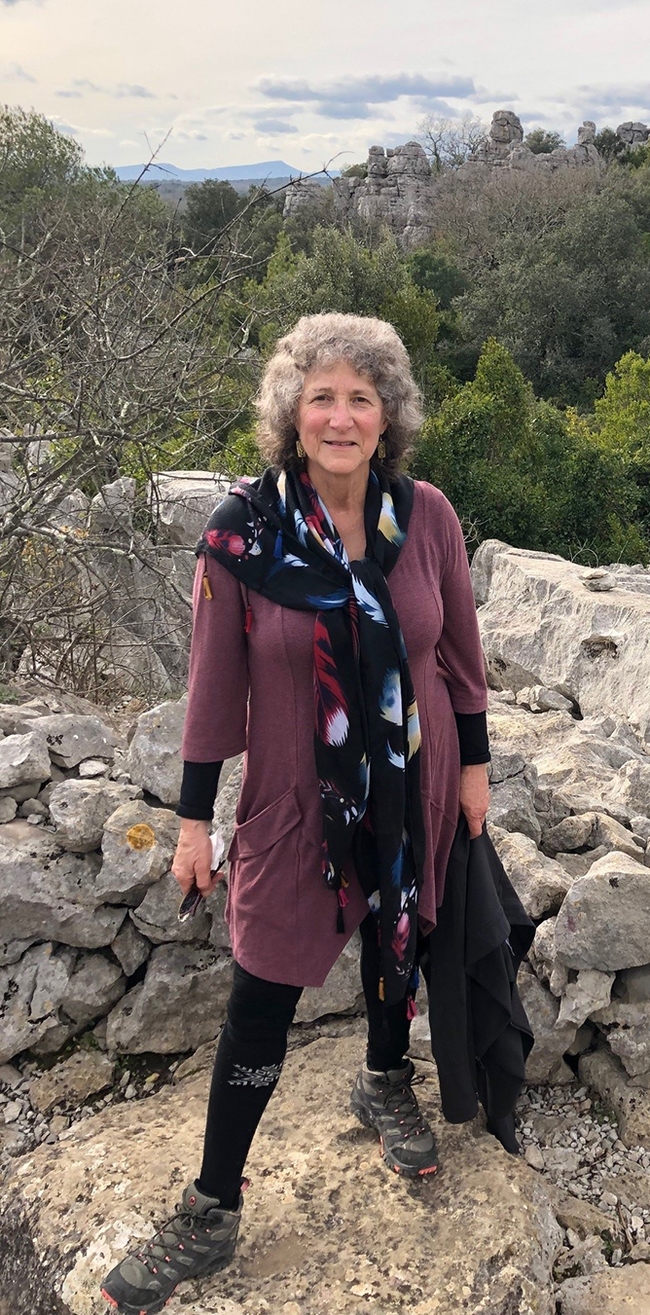
It did: their research revealed how TSWV (family Tospoviridae, order Bunyavirales) packages its RNA genome, a crucial step in virus infection.
Their newly published research, “The Genome of a Bunyavirus Cannot be Defined at the Level of the Viral Particle But Only at the Scale of the Viral Population,” appears in the current edition of the Proceedings of the National Academy of Sciences (PNAS).
The 18-member research team included scientists primarily from the French National Research Institute for Agriculture, Food and Environment (INRAE) at the Campus International de Baillarguet, Montpellier; Department of Entomology, University of Wisconsin; and the Department of Entomology and Nematology, University of California, Davis.
“Our work showed the genome of TSWV can only be defined at the population level, pointing at emerging properties when viral particles infect plants in groups,” said a key author Stéphane Blanc, research director of INRAE's Biology and Genetics of Plant-Pathogen Interactions. “As most virions contain an incomplete genome, TSWV is a multi-component viral system, where co-infection and complementation are key in the life cycle. These findings open a myriad of possibly distinct properties depending on the genetic composition of the group of virions co-infecting a cell.”
“The most challenging part of this work was to create a protocol reliably quantifying the two polarities of each segment,” said lead author Michel Yvon of INRAE. “The next important advance will be to demonstrate that co-infection of cells by a group of particles is key to the spread of infection.”
Ullman, an international authority on orthotospoviruses and one of the four main authors, took a sabbatical to work on the project. “My interest was in understanding how TSWV packaged its RNA genome,” she said. “While this sounds like a simple goal, it is quite complex because TSWV has negative sense and ambisense viral strands and many research tools common to studying other viruses, such as infectious clones were not available.”
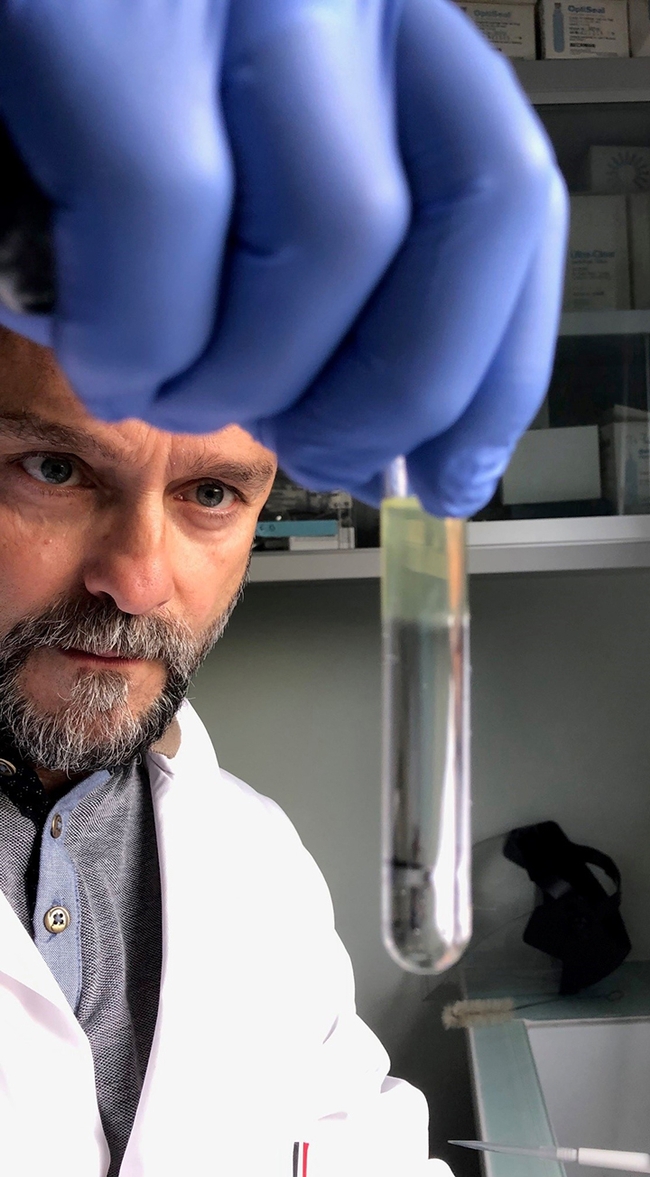
“It was a delight to work with the fantastic team of scientists that Stéphane assembled, all very talented with skills in virology, cryoelectron microscopy and nanopore PCR,” Ullman commented. “I cannot imagine a more talented and diverse group of people to conduct this difficult work. I learned a great deal about virus purification from Michel Yvon, whose leadership, skills in virology, and patient teaching really moved our project forward."

German, professor emeritus and former chair of both the Departments of Plant Pathology and Entomology at the University of Wisconsin, died Aug. 27, 2023 at age 82.
“I am indebted to my husband, Jean-Marc Leininger who frequently drove me to the laboratory in Avignon where I was able to rear thousands of virus-infected plants and to store TSWV isolate,” Ullman added. “Jean-Marc not only transported me and my virus specimens, but also learned to mechanically inoculate plants and helped with every inoculation and virus harvest.”
UC Davis postdoctoral scholar Sulley Ben-Mahmoud of the Ullman lab was among the co-authors.
Funding was provided by grants from Montpellier University of Excellence (MUSE); Floriculture and Nursery Research Initiative, U.S. Department of Agriculture, Agricultural Research Service (USDA-ARS); and the Fulbright Scholar Program. The authors also acknowledged support from
- Santé des Plantes et Environnementor Plant Health and Environment (SPE)
- Centre National de la Recherche Scientifique (CNRS)
- Institute of Research for Development (IRD)
- Institut national de la santé et de la recherche médicale (INSERM)
- Centre for International Cooperation in Agronomic Research for Development (CIRAD)
- Plant Health Institute of Montpelier (PHIM)
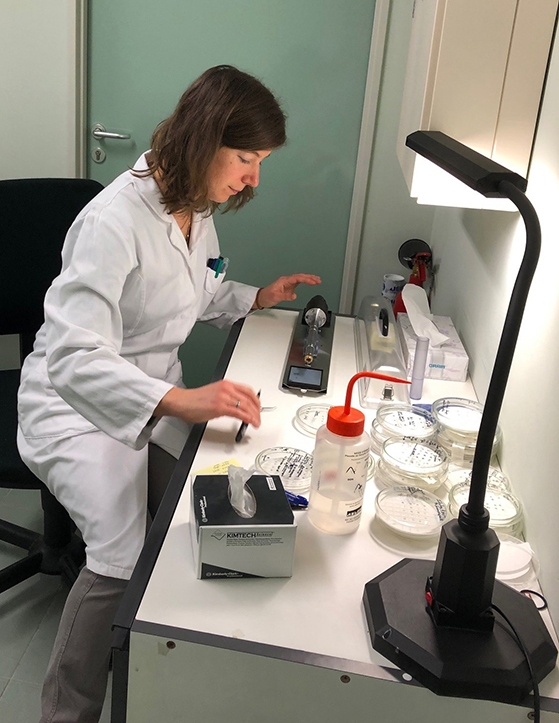
Ullman noted the importance of the research in her Fulbright application: “Sustainable management of insect-transmitted pathogens is a key concern for food production in France and the United States. Both countries grow many of the same crops and growers face similar challenges from insect-transmitted plant viruses. Current management strategies rely heavily on pesticides that may cause significant health and environmental concerns, including damage to bees and other pollinators, as shown with neonicotinoid pesticides. Clearly, better knowledge about these insect-transmitted viral systems…has potential to reduce pesticide use by providing novel and innovative technologies to manage orthotospoviruses and thrips in France and the United States.”
Ullman, a former chair of the Department of Entomology and a former associate dean of the UC Davis College of Agricultural and Environmental Sciences, anticipates strong research relationships between UC Davis and Montpellier that will lead to grant applications for international research and scholarly exchange opportunities for scientists, students, and post-doctoral scholars.
Significance
In their significance statement, the authors wrote: “Bunyaviruses infect animals, plants, fungi, and protists. Despite their importance, fundamental aspects of their biology as basic as the definition of their genome remain elusive. The viral genome consists of several negative or ambisense RNA segments, and virions often miss segments and/or package complementary strands. We formally quantify this heterogeneity on the species Tomato spotted wilt orthotospovirus. Within individual virus particles, the number, the identity, and the polarity of the segments are widely variable. In contrast, we show that a stable genetic composition is an emerging property of the viral population, each of the RNA segments/polarities accumulating reproducibly at a specific frequency. This resembles the genome formula of multipartite viruses, suggesting that bunyaviruses may also function as multicomponent viral systems.”

Their abstract: “Bunyaviruses are enveloped negative or ambisense single-stranded RNA viruses with a genome divided into several segments. The canonical view depicts each viral particle packaging one copy of each genomic segment in one polarity named the viral strand. Several opposing observations revealed nonequal ratios of the segments, uneven number of segments per virion, and even packaging of viral complementary strands. Unfortunately, these observations result from studies often addressing other questions, on distinct viral species, and not using accurate quantitative methods. Hence, what RNA segments and strands are packaged as the genome of any bunyavirus remains largely ambiguous. We addressed this issue by first investigating the virion size distribution and RNA content in populations of the tomato spotted wilt virus (TSWV) using microscopy and tomography. These revealed heterogeneity in viral particle volume and amount of RNA content, with a surprising lack of correlation between the two. Then, the ratios of all genomic segments and strands were established using RNA sequencing and qRT-PCR. Within virions, both plus and minus strands (but no mRNA) are packaged for each of the three L, M, and S segments, in reproducible nonequimolar proportions determined by those in total cell extracts. These results show that virions differ in their genomic content but together build up a highly reproducible genetic composition of the viral population. This resembles the genome formula described for multipartite viruses, with which some species of the order Bunyavirales may share some aspects of the way of life, particularly emerging properties at a supravirion scale.”
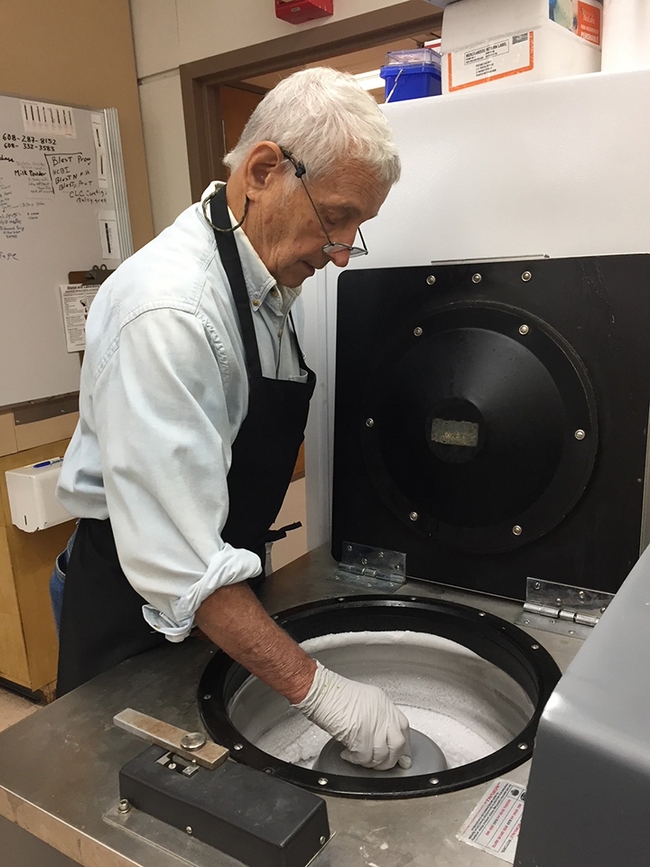
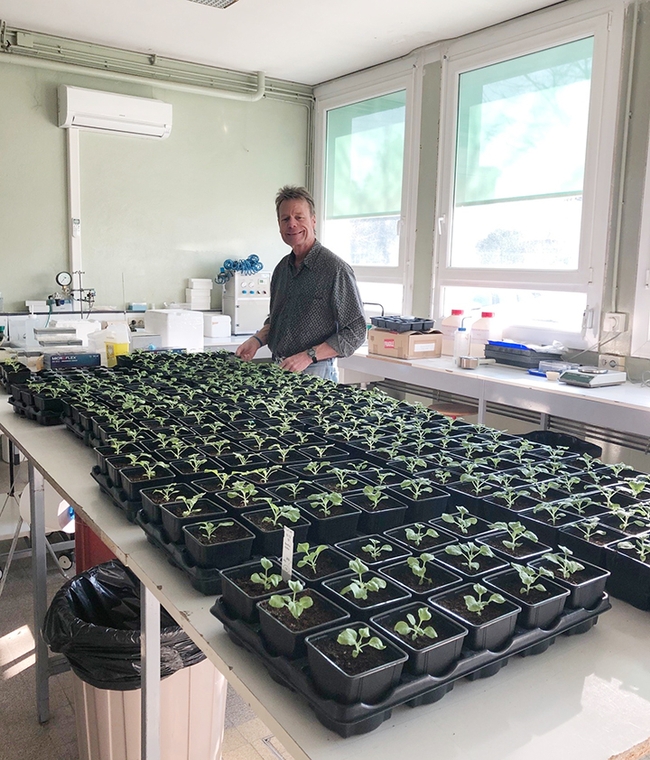
- Author: Kathy Keatley Garvey
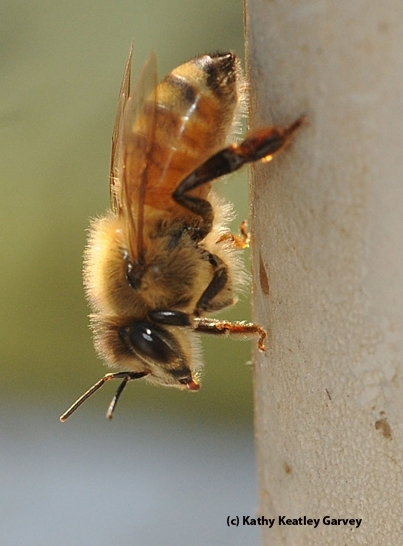
Nieh will present his seminar at 4:10 p.m., Monday, Dec. 4 in Room 122 of Briggs Hall and also on Zoom. The Zoom link:
https://ucdavis.zoom.us/j/95882849672
"Karl von Frisch referred to the waggle dance as the 'magic well' for the insights that it provides not only on honey bees, but on the general cognitive complexity that social insects are capable of," Nieh writes in his abstract. "New research demonstrates that the neurotransmitter, dopamine, the 'pleasure molecule' plays a similar hedonic role in honey bees as it does in many vertebrates, regulating the perception of danger and the anticipation of food rewards as revealed in the excitatory waggle dance and the associated, inhibitory stop signal. I will also discuss new data showing that the honey bee waggle dance is partially learned and has elements that may be culturally transmitted. Together, these findings, demonstrate that the waggle dance can teach us a great deal about shared cognitive mechanisms and the importance of social learning across taxa."
In an article titled "Unlocking Secrets of the Honeybee Dance Language--Bees Learn and Culturally Transmit Their Communication Skills," and published March 9, 2023 in The Conversation, Nieh described the waggle dance as "one of the most complicated examples of nonhuman communication. They can tell each other were to find resources such as food, water, or nest sites with a physical 'waggle dance.' this dance conveys the This dance conveys the direction, distance and quality of a resource to the bee's nestmates."
Nieh related exactly how the bees perform the waggle dance. "Essentially, the dancer points recruits in the correct direction and tells them how far to go by repeatedly circling around in a figure eight pattern centered around a waggle run, in which the bee waggles its abdomen as it moves forward. Dancers are pursued by potential recruits, bees that closely follow the dancer, to learn where to go to find the communicated resource."
"Longer waggle runs communicate greater distances," Nieh wrote, "and the waggle angle communicates direction. For higher-quality resources such as sweeter nectar, dancers repeat the waggle run more times and race back faster after each waggle run."
Nieh noted that "The Greek historian Herodotus reported over 2,000 years ago on a misguided forbidden experiment in which two children were prevented from hearing human speech so that a king could discover the true, unlearned language of human beings.
"Scientists now know that human language requires social learning and interaction with other people, a property shared with multiple animal languages. But why should humans and other animals need to learn a language instead of being born with this knowledge, like many other animal species?"
Nieh went on to point out that "This question fascinates me and my colleagues and is the basis for our recent paper published in the journal Science. As a biologist, I have spent decades studying honeybee communication and how it may have evolved."
Nieh received his bachelor's degree from Harvard University in 1991 and his doctorate from Cornell University in 1997. He completed a postdoctoral fellowship funded by NSF-NAT0 (National Science Foundation, North Atlantic Treaty Organization) at the University of Würzburg, Germany. He served as a Harvard Junior Fellow from 1998-2000
Seminar coordinator is Brian Johnson, associate professor, UC Davis Department of Entomology and Nematology. For Zoom technical issues, he may be reached at brnjohnson@ucdavis.edu. The list of seminars is posted here.
Resources:
- Social Signal Learning of the Waggle Dance in Honey Bees, March 9, 2023, Science
- Bees Can Teach Their Young to Dance, March 9, 2023, Washington Post
- The Waggle Dance, PBS documentary on YouTube

- Author: Kathy Keatley Garvey

Newly retired from teaching but not entirely from research, Page holds the titles of ASU Provost Emeritus and Regents Professor Emeritus, as well as UC Davis Entomology Chair Emeritus.
Bee World published his article, "The Art of the Bee," as well as a one-on-one interview with editor Robert Brodschneider in a piece titled "Robert E. Page Jr--Mapper of the Genetic Architecture of the Honey Bee."
In his article, Page zeroes in on his latest book, The Art of the Bee: Shaping the Environment from Landscapes to Societies, 2020, Oxford University Press), focusing on the importance of honey bees and making science understandable to the public.
Page applauds the work of Alexander von Humboldt (1769-1859), known as a German geographer, naturalist, explorer, and proponent of Romantic philosophy and science.
"Von Humboldt appealed to artists to learn about nature, and ecology, and paint it," Page wrote. "He believed that artists and writers could do more to advance an understanding of science and nature than the scientific specialist. His plea was for making science understandable to the public, a plea for popular science."
Page strongly supports that plea. Earlier this year, he created a free and publicly accessible YouTube channel, "The Art of the Bee," at https://www.youtube.com/@artofthebee to do just that.
His YouTube channel guides the viewer through "the fascinating biology and behavior of the bee," presented in 38 videos from 4 to 27 minutes in length. He organized the videos into six series that roughly correspond to the nine chapters of the book. He included "a rich set of illustrations, images, and videos, to paint a narrative in the spirit of von Humboldt."
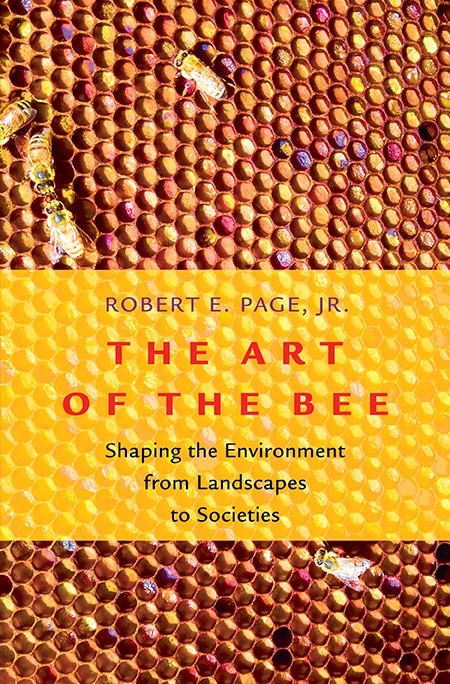
In the first segment, Page writes: "One hundred twenty-five million years ago, the earth exploded with colour with the rapid evolution of flowering plants. The explosion coincided with a rapid increase of species of bees. The bees and flowering plants were locked in a dialectical dance of coevolution, each becoming adapted to the other. The flowers evolved to exploit the feeding habits of bees, and bees evolved to rob the flowers of their precious loads of pollen and nectar. Bees became social and developed communication and navigational systems to better exploit their environment. They continue to transform our world through their effects on the agricultural landscapes and the food we eat. Honey bees have evolved mechanisms to forage optimally both as individuals and colonies, expending their energy and short lives to maximally provision their nest. Their communication system directs foragers to different floral patches at different times of day reflected in the changing kaleidoscope of colour on the legs of returning pollen foragers. Their pollination transforms the landscape in the spring into splashes of colour resembling a painter's pallet."
Page's Bee World article includes this text from his book: "The impact of bees on our world is immeasurable. Bees are responsible for the evolution of the vast array of brightly-colored flowers and for engineering the niches of multitudes of plants, animals, and microbes. They've painted our landscapes with flowers through their pollination activities and have evolved the most complex societies to aid their exploitation of the environment. The biology of the honey bee is one that reflects their role in transforming environments with their anatomical adaptations and a complex language that together function to exploit floral resources. A complex social system that includes a division of labour builds, defends, and provisions nests containing tens of thousands of individuals, only one of whom reproduces. Traditional biology texts present stratified layers of knowledge where the reader excavates levels of biological organization, each building on the last. This book (The Art of the Bee: Shaping the Environment from Landscapes to Societies) presents fundamental biology, not in layers, but wrapped around interesting themes and concepts, and in ways designed to explore and understand each concept. It examines the coevolution of bees and flowering plants, bees as engineers of the environment, the evolution of sociality, the honey bee as a superorganism and how it evolves, and the mating behaviour of the queen."

Native of Bakersfield. A native of Bakersfield, Rob holds a bachelor's degree in entomology (1976), with a minor in chemistry, from San Jose State University. He obtained his doctorate in entomology (1980) from UC Davis; joined the UC Davis faculty in 1989; and chaired the Department of Entomology from 1999 to 2004.
After retiring from UC Davis in 2004, he accepted an appointment at Arizona State University as founding director of the School of Life Sciences. He served as provost of Arizona State University (2013- 2015) and dean of the College of Liberal Arts and Sciences (2011-2013). His research on honey bee behavior and genetics appears in his publications Queen Rearing and Bee Breeding (1997, with Harry H. Laidlaw Jr., his doctoral research mentor at UC Davis and "the father of honey bee genetics"); The Spirit of the Hive, Harvard University Press (2013); and The Art of the Bee, Oxford University Press (2020). His 230-plus research papers have been cited more than 20,000 times.
Much of his research occurred at UC Davis. For 24 years, from 1989 to 2015, Page maintained a honey bee-breeding program, managed by bee breeder-geneticist Kim Fondrk. Their contributions include discovering a link between social behavior and maternal traits in bees. Their work was featured in a cover story in the journal Nature. In all, Nature featured his work on four covers from work mostly done at UC Davis.
Bee World Interview. In the interview with Bee World editor Brodschneider of the Institute of Biology, University of Graz, Austria, Page told him: "I have never been a hobby beekeeper. I have only kept bees for my experimental needs. I have kept more than 300 hives at a time, but I had an excellent technician for about 25 years, Kim Fondrk. Kim could do everything: instrumental insemination, raise queens, manage large numbers of colonies, run gel electrophoresis and PCR in the lab, and even constructed some of the equipment we used in the lab. I was very fortunate because I wasn't a very good beekeeper. I would only pay attention to one thing at a time. I didn't have the eye for seeing apicultural problems."
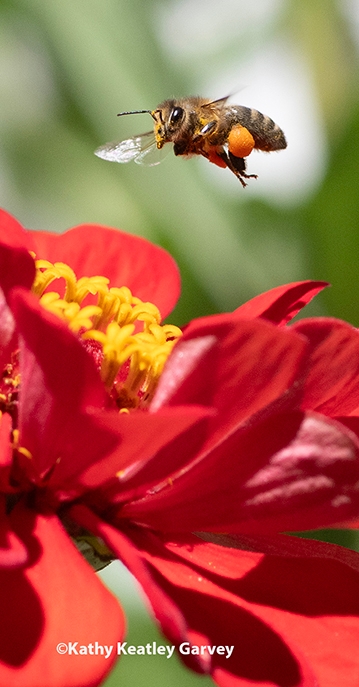
Brodschneider: "What would you rate as your most important research finding in honey bees?"
Page: "I think that must be mapping the phenotypic and genetic architectures of pollen hoarding behavior. It wasn't a fast 'discovery' but the result of 30 years of being fixated on the question 'how do bees evolve complex social behavior.' I used pollen hoarding (the storing of surplus pollen in the nest) as my study phenotype and looked at all levels of biological organization from gene to complex social interactions to construct the architectures."
Brodschneider: "How about your honey bee breeding experiments?"
Page: "I had three over my career. The first was done with Norman Gary (now emeritus professor, UC Davis Department of Entomology and Nematology). We did a bi-directional selection for resistance to tracheal mites. We did this soon after they were introduced into North America and were causing a lot of problems for beekeepers. We successfully selected a line that was resistant to tracheal mites and another that was very susceptible. We demonstrated that it was possible to select for resistance. The bi-directional selection for pollen hoarding went on for 25 years and was very successful. The high strain stored more than 10 times the amount of pollen in the combs than did the low strain. These strains became our tools to dissect the genetic and phenotypic architectures. Gloria Hoffman at the Tucson USDA research lab, Kim Fondrk, and I did a very careful bi-directional selection study on varroa resistance. We were not successful. We were selecting for physiological resistance of larvae to varroa. This was our only failure. I don't think it is really possible to succeed. I don't think there is sufficient genetic variation. Certainly no one has done it more carefully or more controlled than we did."
Brodschneider: "Which big research questions in bees remain unsolved?"
Page: "They are all big. I think understanding the genetic networks that control behavior, development, and resistance to bee diseases will dominate honey bee research for the next generation. But, there is still so much to learn about basic methods of culturing bees such as: in vitro rearing of queens, drones, and workers; maintaining viable colonies of bees in confinement; sperm and embryo storage, nutritional substitutes; controlling the foraging of colonies, etc."
Brodschneider: "Are you still involved in some research?"
Page: "What I think is my final research paper is submitted for publication. I am one of several authors but I am very proud of my contribution. It is a paper about how you can take a large set of gene expression data and derive from it coordinated sets of genes that represent a network of interactions controlling a behavior or a physiological function."
Brodschneider: "Together with Harry Laidlaw you worked on bee breeding in the early 1980s. What has changed since then in the honey bee stock kept in the United States and in the breeding programs?"
Page: "I don't think much has changed at all with respect to commercial breeding programs. Queen producers are still primarily queen producers and not queen breeders. I think they do control their stock somewhat through their culling process when they select queen and drone mother colonies. The very few that do really breed bees, like Sue Cobey (who studied with Laidlaw and later became a bee breeder-geneticist at UC Davis and is now with Washington State University) and her New World Carniolans use traditional breeding methods: measure phenotypes, select parents, control matings, and get stock improvements. Sue is one of the few to use instrumental insemination to control mating. I suspect practices today are much like what has gone on since the beginning of agriculture in human societies. I think there is only so far you can go with these methods because there are constraints on what phenotypes you can 'squeeze' out of the honey bee genome. And there are serious social constraints, for example, if you breed too far for hygienic behavior you can get colonies that tear down all of the comb and don't raise brood. Or if you do like I did, breed colonies to collect too much pollen it is pathological because they plug up the brood nest with pollen. We have not yet seen modern molecular genetic tools provide stock improvement, though there has been some limited use of them for markers used in selection. There are severe obstacles due primarily to its social system. For example, if you genetically modify a queen or workers, larvae or adults, they will be detected by the other workers and eliminated. Changing social structure is complex."
Page described current beekeeping in the United States as "Adaptable and curious. It is amazing how quickly and how well the industry responds to the plethora of problems, old and new, that confront the industry. And they succeed because every commercial beekeeper I ever met was curious and was always experimenting to find better ways."
In other comments, Page said that the most urgent problems in beekeeping today involve "Varroa, varroa, varroa. We have to keep looking for better control and management methods. I have been surprised that researchers and the bee industry have done as well as they have to stay ahead of the potential total disaster that varroa can cause."
Resources:
- "Why Bees Are Artists and Engineers: Robert E. Page's New Book," July 30, 2020, Bug Squad blog, UC Agriculture and Natural Resources
- Rob Page's Newly Launched YouTube Channel: The Fascinating World of Bees," May 4, 2023, UC Davis Department of Entomology and Nematology
- Honey Bee Geneticist Rob Page Named UC Davis Distinguished Professor, Jan. 8, 2018, UC Davis Department of Entomology and Nematology
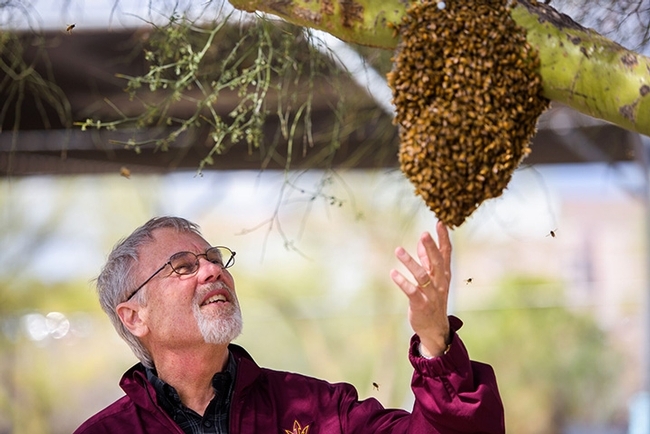
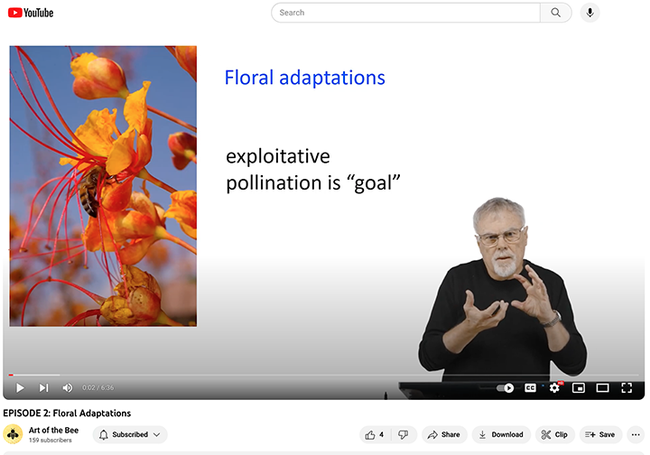
- Author: Kathy Keatley Garvey
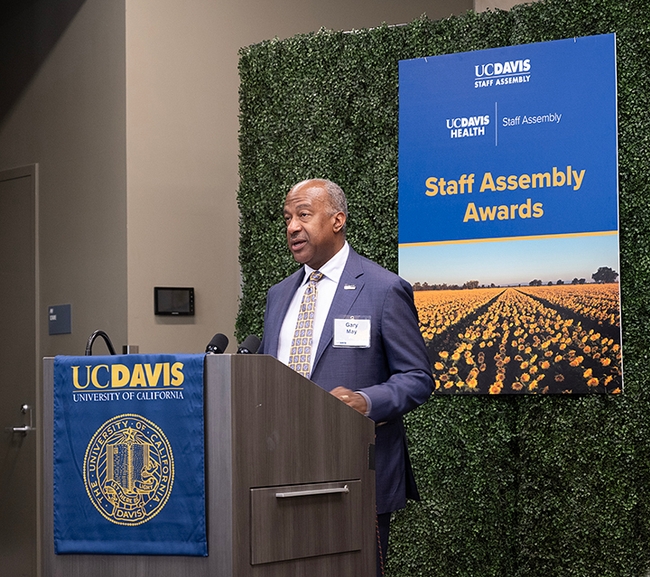
For "outstanding achievements and notable contributions in disseminating science-based beekeeping information since 2016,” the UC Davis-based California Master Beekeeper Program (CAMBP) won a 2023 UC Davis Staff Assembly “Citation of Excellence” and praise from Chancellor Gary May.
CAMBP director and founder Elina Lastro Niño, associate professor of Cooperative Extension and a member of UC Davis Department of Entomology and Nematology faculty, and co-program manager Wendy Mather share the Faculty-Staff Partnership Award.
Niño, UC Extension apiculturist since 2014, founded CAMBP in 2016. Mather joined the program in March of 2018. Also integral to the program is Kian Nikzad, but as a newer employee, was ineligible to be nominated.
The awards ceremony, held Sept. 12 in the International Center on campus, singled out “some of our most exceptional UC Davis individuals and teams,” Chancellor May said in his presentation.
Nikzad accepted the award on behalf of Niño, who was participating in Apimondia in Santiago, Chile, conferring with colleagues at the UC Davis Chile Life Sciences Innovation Center, a part of UC Davis Global Affairs. She was assisting them in developing a sustainable and environmentally friendly science-based beekeeping program to support the success of farmers and beekeepers at all economic levels.
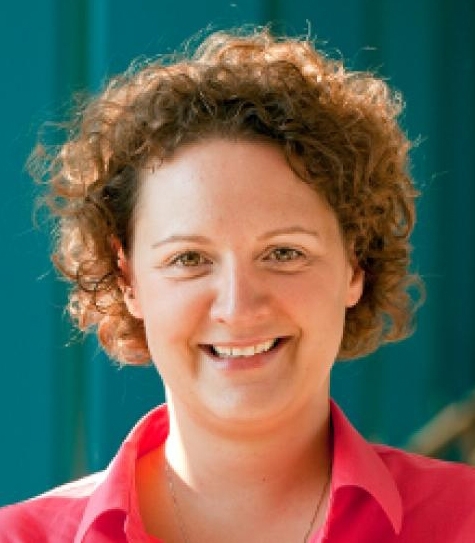
“I truly appreciate everything you do on a daily basis to make UC Davis a wonderful place,” the chancellor said. “You are the heart of UC Davis and I'm grateful for your dedication and hard work...you “contribute to our university's success and make UC Davis a more enjoyable, creative, inclusive and invigorating place to work.”
Nomination. Nominators of "The Bee Team" lauded Niño and Mather for providing a “program of learning, teaching, research, and public service, goes above and beyond in delivering comprehensive, science-based information about honey bees and honey bee health. They continually and consistently develop, improve, and refine their statewide curriculum that educates stewards in a train-the-trainer program to disseminate accurate, timely, and crucial information. Honey bees pollinate more than 30 California crops, including almonds, a $5 billion industry (no bees, no pollination, no almonds). Indeed, California produces more than a third of our country's vegetables and three-quarters of our fruits and nuts. However, colony losses are alarming due to pesticides, pests, predators and pathogens.”
As of Sept. 15, 2023, CAMBP has donated 34,000 hours of volunteer time and served 209,000 individuals in education, outreach and beekeeping mentorship. If a volunteer hour were to be calculated at $26.87, CAMBP has given $913,580 back to California in service of science-based beekeeping and honey bee health.
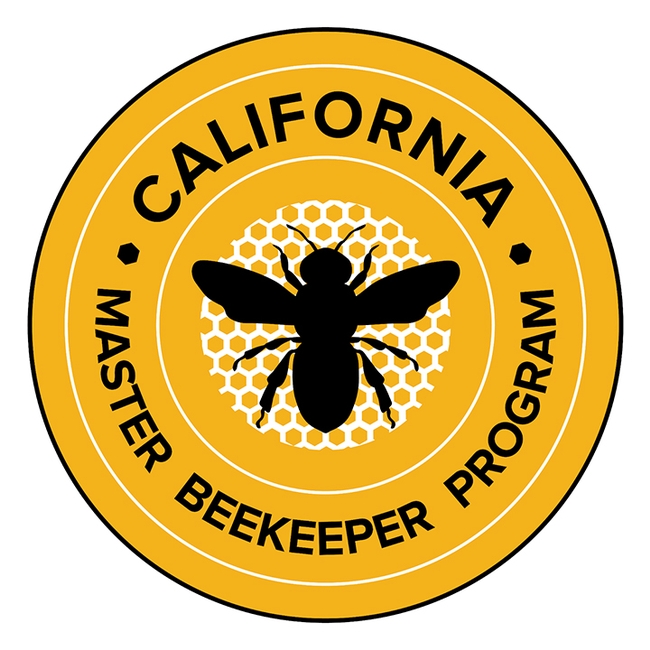
Scholarships. “No money?” wrote the nominators (Kathy Keatley Garvey, Nora Orozco and Tabatha Yang from the Department of Entomology and Nematology). “No problem. (CAMBP) has donated 12 scholarships, worth $250 each; helped novices who can't afford mentoring or equipment by linking them with veteran beekeepers; and is engaging in free bee removals--rescuing and relocating bees.”
Over the past year, CAMBP has developed and expanded its educational materials. This includes launching an asynchronous online course and in-person preparatory programs with its partners. It is updating safety materials and developing an Epinephrine auto-injector/CPR course, geared toward “everyone from 4-H beekeepers to novice beekeepers to the general public,” the nominators wrote.
CAMBP also teaches “schoolchildren about bees at specially guided garden tours at UC Davis, inspiring them “to care for the bees and plant nectar and pollen resources.”
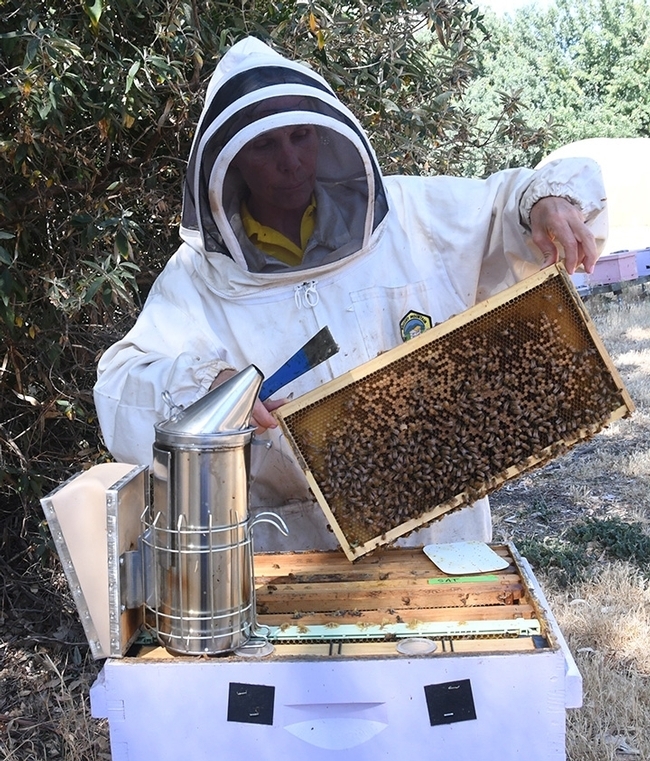
Its website, accessible to the public, offers a list of classes and knowledge-based information, including backyard beekeeping, bees in the neighborhood, bees and beekeeping regulations, defensive bees, live honey bee removals, and protecting pollinators.
“Bottom line,” the nominators concluded, “our ‘B' Team is really an ‘A' Team, an outstanding example of UC Davis teaching, research and service; a team providing exemplary service and contributions; and a team that creates and maintains high morale and embodies the Principles of Community.”
Joint Statement. In a joint statement following the awards ceremony, Mather and Nikzad said: “We share this award with our passionate and caring member volunteers. Our members are deeply committed to honey bee health, science-based beekeeping practices, and, most importantly, to each other. Their enthusiasm and dedication drive our mission forward. We wish to acknowledge Elina Niño for her visionary leadership; she has brought together various stakeholders, including growers, bee breeders, commercial, sideline, and hobbyist beekeepers, as well as the general public, through CAMBP, UC Davis, UC Agriculture and Natural Resources (UC ANR) and UC Cooperative Extension (UCCE). We missed having her at the ceremony.”
At the Staff Assembly ceremony, one other team received a Faculty-Staff Partnership Award Excellence Award: the Graduate Mentoring Initiative, comprised of Ambarish Kulkarni, faculty, Department of Chemical Engineering; Pamela Lein, faculty, Department of Molecular Bioscience; and Elizabeth Sturdy, staff, director of the Mentoring and Academic Success Initiative, Graduate Studies.
Serving as co-chairs of the 2023 Citations of Excellence Committee were Darolyn Striley, manager of the Office of Student Development, School of Medicine, and Mary Carrillo, business operations manager, Languages and Literatures.
Staff Assembly sponsors the annual Citations of Excellence awards program to provide recognition for UC Davis and UC Davis Health individual staff and staff teams “who have demonstrated outstanding achievement in one of the following areas: teaching, research, service, innovation, supervision, mentorship, team awards and faculty/staff partnership award.”
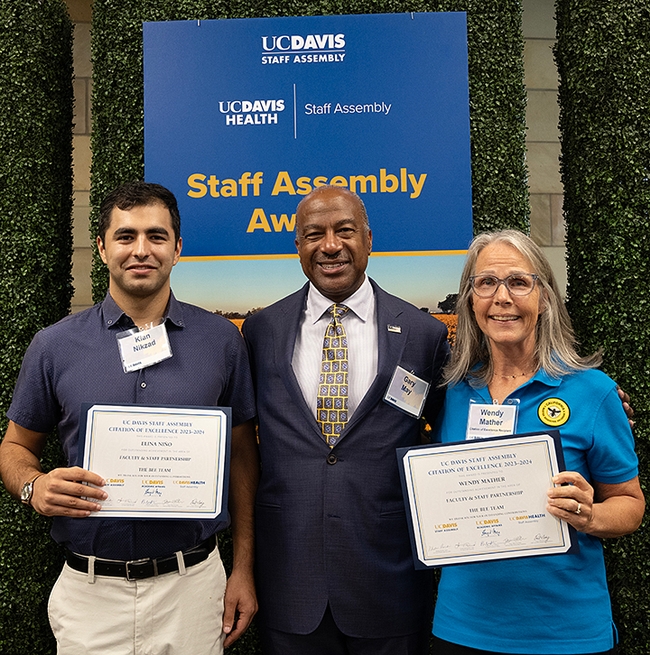
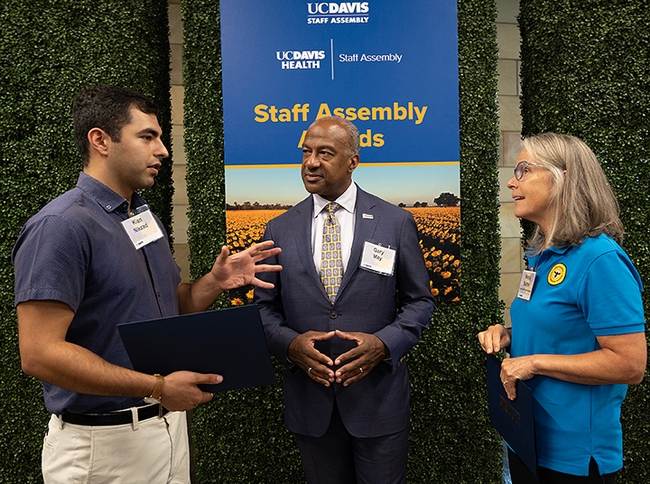
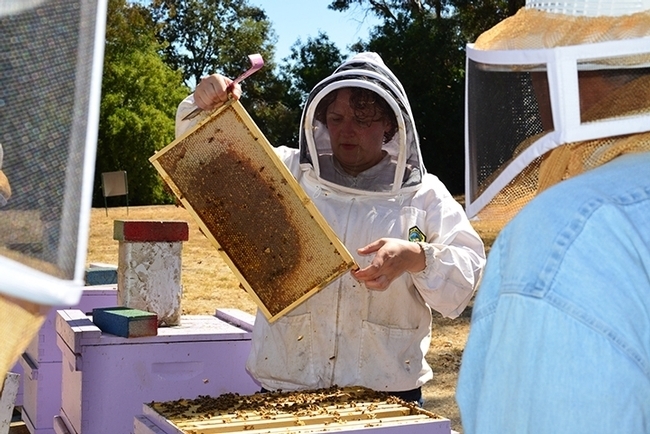
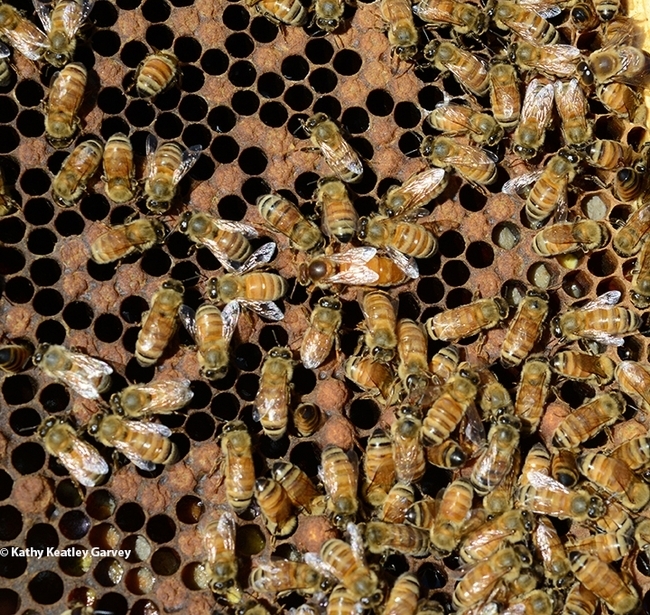
- Author: Kathy Keatley Garvey

Noted entomologist and UC Davis doctoral alumnus Michael Hoffmann, an emeritus professor at Cornell University known for his advocacy of climate change literacy and the relationship between food and climate change, plus his leadership activities and biological control projects, will deliver the Thomas and Nina Leigh Distinguished Alumni Award Seminar on Monday, Oct. 9 in the Student Community Center, UC Davis.
The Leigh seminar, hosted by the UC Davis Department of Entomology and Nematology, annually honors distinguished alumni. Hoffmann was selected the 2020 recipient, but the COVID pandemic intervened. This is first seminar since the beginning of COVID pandemic.
Hoffmann will present his lecture from 4 to 5 p.m., in Room D, second floor of the Student Community Center. It is free and open to the public and no reservations are required.
An invitational reception and buffet dinner will follow in the Student Community Center.
Hoffmann, who received his doctorate in entomology in 1990 from UC Davis, studying with Professor Ted Wilson and later Professor Frank Zalom, will present the seminar on “Our Changing Menu--Climate Change and the Foods We Love and Need,” the title of a book he co-authored with Carrie Koplinka-Loehr, and Danielle Eiseman in April, 2021.
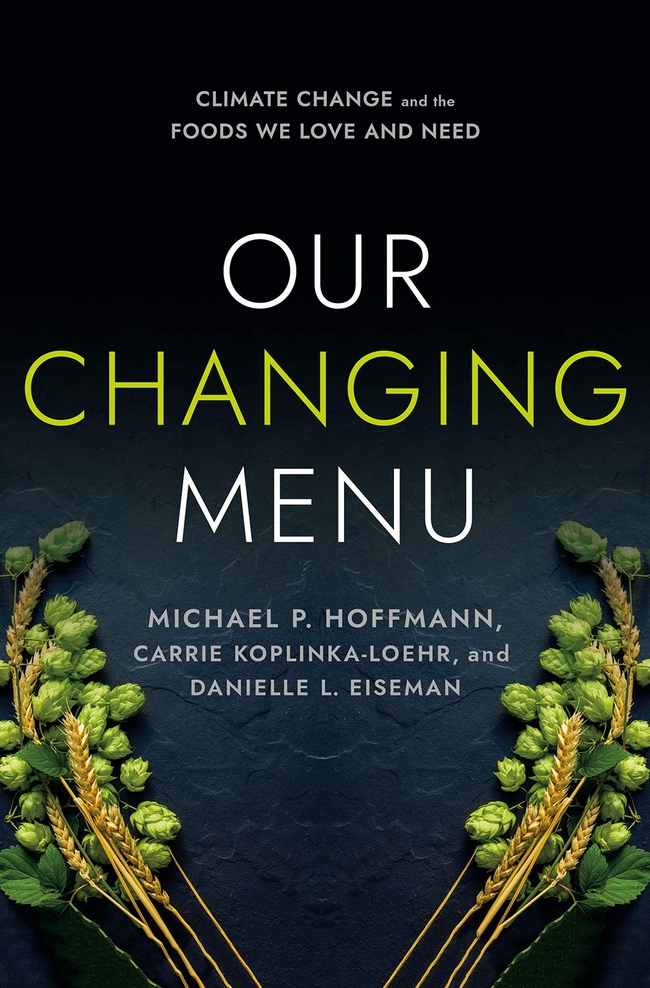
The co-authors "offer an eye-opening journey through a complete menu of before-dinner drinks and salads; main courses and sides; and coffee and dessert. Along the way they examine the escalating changes occurring to the flavors of spices and teas, the yields of wheat, the vitamins in rice, and the price of vanilla." They round out their story "with a primer on the global food system, the causes and impacts of climate change, and what we can all do. Our Changing Menu is a celebration of food and a call to action?encouraging readers to join with others from the common ground of food to help tackle the greatest challenge of our time."
Hoffmann transitioned to emeritus in January 2020 after 30 years at Cornell, but remains active. Serving as executive director of the Cornell Institute for Climate Smart Solutions (2015-2020), he continues to provides visionary leadership, communicates to a wide range of audiences the challenges and opportunities that come with a changing climate, and builds partnerships among public and private organizations.
Hoffmann's leadership activities include co-chairing the President's Sustainable Campus Committee and helping to lead a climate change literacy initiative for students, staff, and faculty. He dedicates his time toward what he calls “the grand challenge of climate change and (to) help people understand and appreciate what is happening through food.” Effectively communicating about climate change, Hoffmann presented a TEDX talk in 2014 on “Climate Change: It's Time to Raise Our Voices” that drew widespread attention.
A native of Wisconsin, Hoffmann holds a bachelor of science degree (1975) from the University of Wisconsin, and his master's degree from the University of Arizona (1978). He served with the U.S. Marines in Vietnam from 1967 to 1971, achieving the rank of sergeant.
UC Davis Experiences. Hoffmann remembers well his experiences at UC Davis. “I was privileged to work with many dedicated faculty in entomology and several other departments.”
After receiving his doctorate at UC Davis, Hoffmann joined the faculty of Cornell in 1990 as an assistant professor, with 60 percent Extension and 40 percent research duties, and advanced to associate professor in 1996, and professor in 2003. His academic career focused on administrative endeavors (80 percent) beginning in 1999.
Hoffmann's career at Cornell included serving as associate dean of the College of Agriculture and Life Sciences, associate director of Cornell Cooperative Extension, director of the Cornell University Agricultural Experiment Station, and director of the New York State Integrated Pest Management Program. He helped initiate a leadership and professional development week-long program that benefited more than 400 faculty at Cornell and beyond.
Prior to his administrative duties, he worked to develop and implement cost-effective and environmentally sensitive tactics for management of insect pests. He emphasized biological control, development and application of insect behavior modifying chemicals, and novel control tactics, all in an integrated pest management (IPM) context. Much of his research and Extension programming was multi-state and multidisciplinary in nature.
Among his entomological achievements, he
- Developed unique, cost-effective and environmentally benign biological control tactics for insect pest of sweet corn, peppers and potatoes, and presented wide scale demonstrations on conventional and organic farms in New York, Virginia, Massachusetts and Canada.
- Published the first popular guide to beneficial insects (64 pages, with more than 5,000 copies distributed)
- Developed patented unique fiber barrier technology for pest control

His publication record includes 105 refereed journal articles, nine book chapters, and three books.
Leigh Seminar. The Leigh seminar memorializes cotton entomologist Thomas Frances Leigh (1923-1993), an international authority on the biology, ecology and management of arthropod pests affecting cotton production. During his 37-year UC Davis career, Leigh was based at the Shafter Research and Extension Center, also known as the U.S. Cotton Research Station. He researched pest and beneficial arthropod management in cotton fields, and host plant resistance in cotton to insects, mites, nematodes and diseases. In his memory, his family and associates set up the Leigh Distinguished Alumni Seminar Entomology Fund at the UC Davis Department of Entomology. When his wife, Nina, passed in 2002, the alumni seminar became known as the Thomas and Nina Distinguished Alumni Seminar.
Leigh joined the UC Davis Department of Entomology in 1958, retiring in 1991 as an emeritus professor, but he continued to remain active in his research and collaboration until his death on Oct. 26, 1993. The Pacific Branch of the Entomological Society of America awarded him the C. F. Woodworth Award for outstanding service to entomology in 1991.
Resources:
'Our Changing Menu': Warming Climate Serves Up Meal Remake" Cornell



